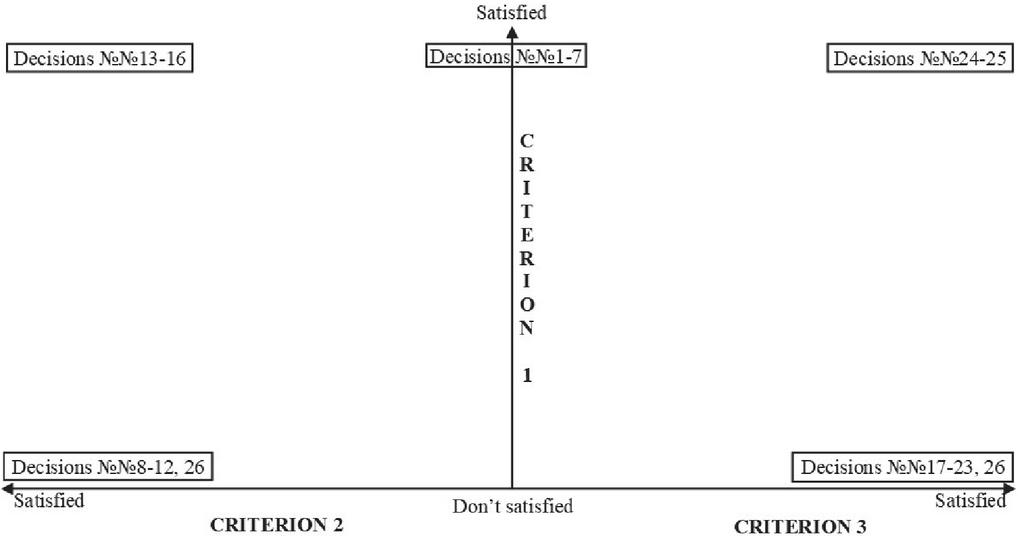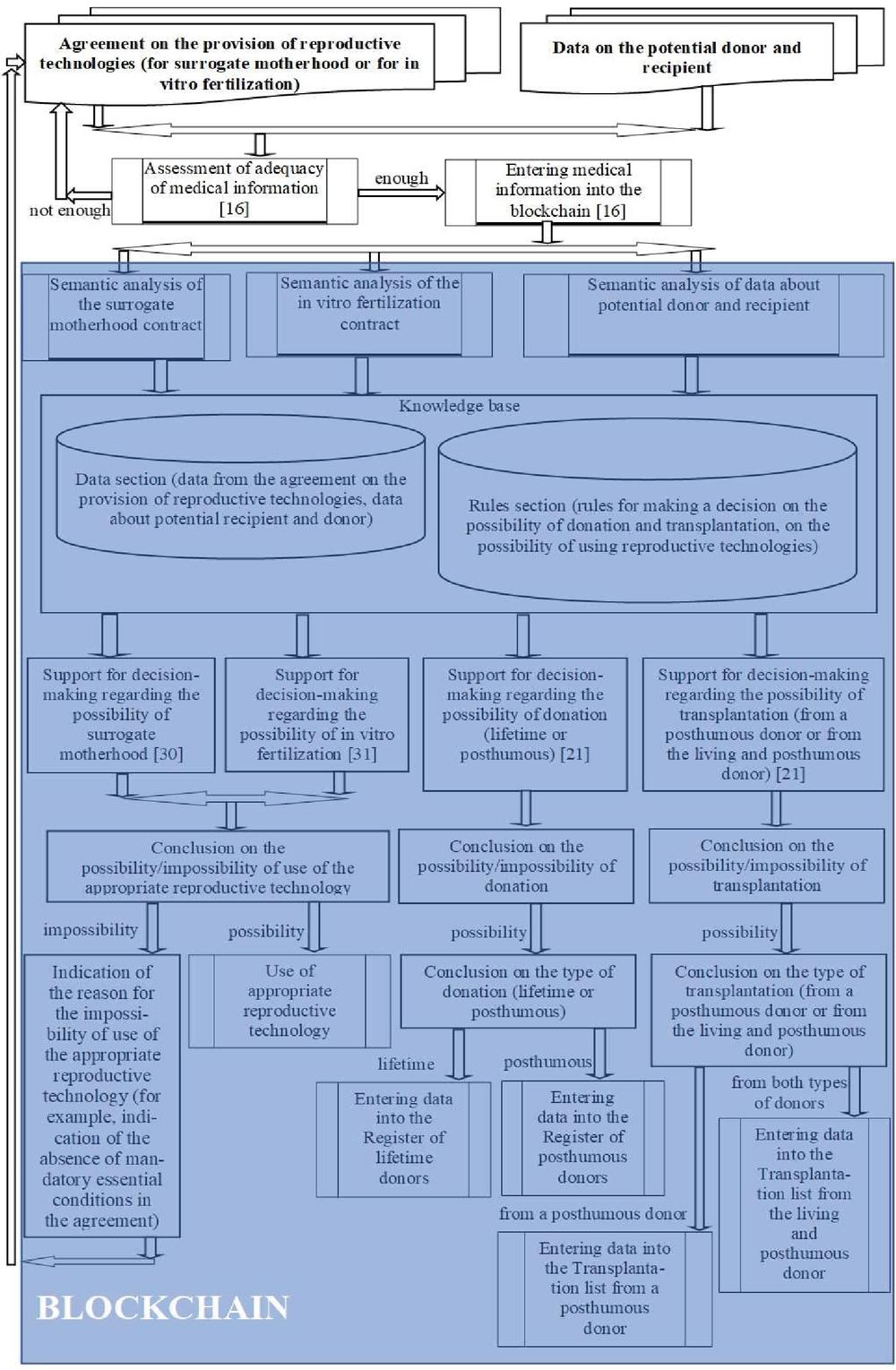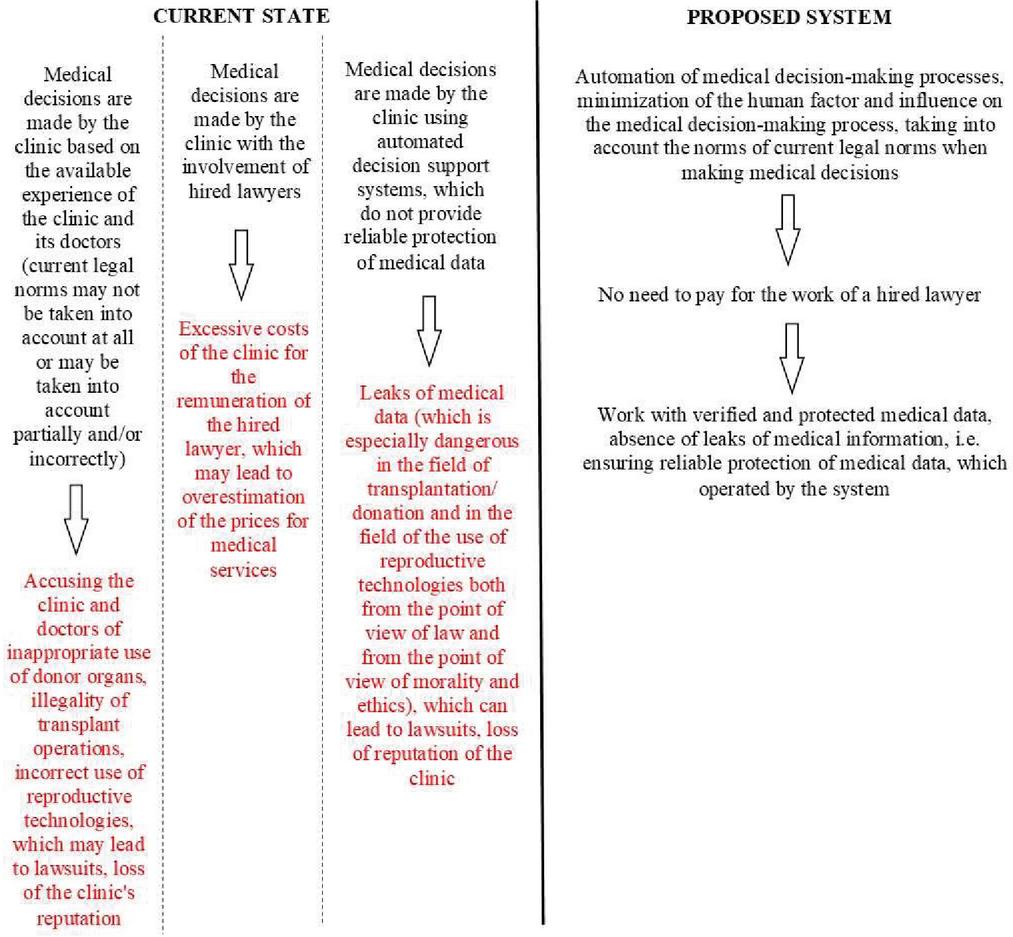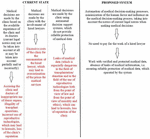Blockchain-Based Medical Decision Support System
Tetiana Hovorushchenko1,*, Yelyzaveta Hnatchuk1, Vitaliy Osyadlyi1, Mariia Kapustian1 and Artem Boyarchuk2
1Department of Computer Engineering & Information Systems, Khmelnytskyi National University, Khmelnytskyi, Ukraine
2Department of Law, Tallinna Tehnikaülikool (TalTech), Tallinn, Estonia
E-mail: hovorushchenko@khmnu.edu.ua; hnatchukY@khmnu.edu.ua; vitalik9865@gmail.com; kapustianM@khmnu.edu.ua; artem.boyarchuk@taltech.ee
*Corresponding Author
Received 28 October 2022; Accepted 16 November 2022; Publication 16 May 2023
Abstract
An urgent task at this moment is the use of blockchain technology to ensure the security of medical decision support systems (MDSS). Our research is devoted to development of blockchain-based MDSS (regarding possibility or impossibility of organ and tissue donation/transplantation, regarding possibility or impossibility of using reproductive technologies in the treatment of infertility). The developed blockchain-based medical decision support system provides reliable protection and security of medical information through the use of blockchain technology, provides support of decision regarding possibility or impossibility of organ and tissue donation/transplantation, provides support of decision regarding possibility or impossibility of use of reproductive technologies in the infertility treatment. The proposed blockchain-based medical decision support system: automates medical decision-making processes, minimizes the human factor and its influence on the medical decision process, and takes into account the norms of current legislation when making medical decisions, thereby allowing not to pay for the services of a hired lawyer, and also works with verified and protected medical data entered in the blockchain, which allows you to get rid of leaks of medical information and to ensure reliable protection of medical data.
Keywords: Blockchain, medical decisions, medical data, medical information, security, reliability, medical decision support system (MDSS).
1 Introduction
Healthcare is one of the large and busy world’s sectors, which has at every stage a lot of manual labor and moderation. The greater part of clinical patient-related documents is handwritten, and only selected documents and reports are generated by machine. Manual moderation of medical documents increases the probability of incorrect diagnosis, medical error, which poses a risk to the patient’s life as a result. Medical errors can be the result of incorrectly compiled documentation, illegible handwriting of the doctor or incorrect actions of the patient. There are various ways to reduce medical error, for example, using IT approaches to work with medical patient-related information. In recent years, the information technologies began to be rapidly used in the digitalization of all healthcare field processes. At the same time, the current development of healthcare field and medicine is first and foremost based on the automation of the different processes for supporting the timely and correct medical decisions [1, 2].
Of course, the security and protection of medical data should be taken into account when using IT approaches. Because of the ethical and legal implications of leaking patient medical data, the security and protection of medical data is a critical and challenging issue in healthcare. Solving the problem of ensuring the security of medical data will have a triple impact: secure processing of confidential information, contribution to the development of international medicine and provision of personalized care [2–4].
Cloud technologies, mobile technologies, artificial intelligence technologies, digital registries, tokenization are tools for promising the advance of the healthcare industry by increasing patient involvement in all processes, empowering participants with control of their data, removing a barrier for participation in research. Blockchain technologies consolidate these tools together and are significant trust’s element for use with purpose of more meaningfully engaging the public in clinical research [5]. Blockchain technology is a solution to ensure the confidentiality of stored data in the healthcare industry. Blockchain, in consequence of its features, provides the required guarantees for safe exchange, processing and management of confidential patient information. Blockchain provides both greater visibility, greater security, and safely and cheaply store of information without additional resources of trusted authority, i.e. blockchain-based systems are more transparent and more accountable. The main characteristics of blockchain are guaranteeing the information security and users’ privacy, decentralization without third-party institutions’ involvement [6].
Blockchain made it possible to organize data storage and synchronization even among parties that do not trust each other, since all attempts to replace data recorded at a certain level cause changes at all subsequent levels, therefore, they will be noticed by all participants in the system [6].
Properties that the use of blockchain provides to systems: (1) integrity of the database change history; (2) minimizing the synchronization and backup delays; (3) the possibility of simultaneous work of a group of validators; (4) the possibility of conducting an audit in real time; (5) the possibility of using light clients and SPV nodes; (6) timestamping; (7) trustlessness [6].
Currently, activity of researchers devoted to blockchain applying in the medical and healthcare field are focused on the security of medical information and the implementation of electronic medical records through the blockchain. Blockchain-based systems empower patients at the expense of providing them with a sense of their medical information control. The use of blockchain gives reason to patients sharing their medical information with blockchain-based systems, improves diagnosis, and reduces healthcare costs [7]. On the other hand, some other areas still remain understudied – for example, the implementation of IoT systems, the implementation of automated diagnostic systems, as well as the implementation of medical decision support systems [8, 9].
So, an urgent problem at this moment is the use of blockchain technology to ensure the security of medical decision support systems (MDSS).
The main contribution of this paper for solving such urgent problem is the proposed blockchain-based MDSS, which: automates medical decision-making processes, minimizes the human factor and their influence on the medical decision-making process, and takes into account the norms of current legislation when making medical decisions, thereby allowing not to pay for the services of a hired lawyer, and also works with verified and protected medical data entered in the blockchain, which allows you to get rid of leaks of medical information and to ensure reliable protection of medical data.
The remaining portions of our paper are structured as follows. Section 2 summarizes the study of the known medical decision support systems. Section 3 is a brief description of the problem statement. Section 4 is a description of the proposed blockchain-based medical decision support system, Section 5 provides the results of the proposed systems functioning and discussion about proposed system advantages, and Section 6 provides the conclusions.
2 Study of the Known Medical Decision Support Systems
We considered the known MDSS and solutions regarding the possibility or impossibility of organ and tissue donation/transplantation, as well as the possibility or impossibility of reproductive technologies use in the treatment of infertility (in vitro fertilization and surrogate motherhood) as a type of donation (donation of reproductive materials – embryos, eggs, gametes, etc.).
From the standpoint of ensuring the security of medical decision-making support systems, we have to define whether the MDSS or solution provides security and protection of medical information using blockchain technology – criterion 1; whether they provide medical decisions support regarding the possibility or impossibility of organ and tissue donation/transplantation – criterion 2; whether they provide support medical decision support regarding the possibility or impossibility of using reproductive technologies in the treatment of infertility – criterion 3.
We summarized the results of the conducted study of the known MDSS and solutions in terms of their satisfaction with the above criteria – Table 1.
Table 1 The conducted study results of the known MDSS and solutions in terms of their satisfaction with the above three criteria
| Criterions | ||||
| Medical Decision Support System/Model/Method | 1 | 2 | 3 | |
| 1 | Blockchain for the systems of health information exchange [10] | |||
| 2 | Model on the basis of blockchain technologies for increasing the accountability, security, transparency of sharing the medical information between many different stakeholders by smart contracts [11] | |||
| 3 | Soteria – the privacy-preserving framework based on the smart contracts for management, share and analysis of the clinical trial information on private fabric chaincode with fewer participants and with an efficient consensus protocol [12] | |||
| 4 | Cost-efficient patient-centered architecture – system for electronic health record on the basis of interplanetary file system, blockchain, cryptographic functions for safe control of access with medical information’s transparency, immutability, accountability [13] | |||
| 5 | Lionized Golden Eagle based Homomorphic Elapid Security algorithm for the blockchain-based cybersecurity in healthcare networks, which provides the security of the medical image by using hash function [14] | |||
| 6 | Techniques for processing of electronic health records using cybercrimes prevention mechanisms, cryptographic cloud-based model, and cyber blockchain technology [15] | |||
| 7 | Blockchain-based medical data management’s methods [16] | |||
| 8 | Hybrid feature selection model on the basis of ant colony optimization and k-nearest neighbor classifier for investigation of the relationship between the most defining features of donors/recipients and success of lung transplantation based on the data from the United Network of Organ Sharing [17] | |||
| 9 | ML algorithms in predictive modeling of donor–recipient matching, waitlist mortality, post-transplant complications diagnosis, survival prediction, and prediction of optimal immunosuppression [18] | |||
| 10 | Fuzzy Inference System for ranking the patients on the basis of the factors of kidney allocation, which mimic the decision-making process considering the complexity of kidney allocation based on the expert intuitive thinking [19] | |||
| 11 | Automated referral system, which minimizes subjective decision-making by very busy hospital staff, allows organ procurement organizations rapidly find out about medically eligible potential donors, and evaluates the impact on eligible donor referral [20] | |||
| 12 | Decision-making support system about the donation’s and transplantation’s possibility on the basis of civil legal norms [21] | |||
| 13 | Blockchain-based framework for organ and/or tissue transplantation – framework for organ and/or tissue transplantation by using the fabric hyperledger environment [11] | |||
| 14 | Private Ethereum blockchain-based end-to-end organ donation and transplantation system, which provides organ donation and transplantation management, guarantees the fairness and efficiency of the organ allocation process and patients’ trust enhancing [22] | |||
| 15 | Secured-smart blood and organ donation web developed blockchain-based system, which is transparent and only available only by authorized users by Ethereum Smart Contract [23] | |||
| 16 | Blockchain-based organ allocation algorithms on the examples of kidney allocation for solving some of the existing issues in the area of organ donation – different organ allocation policies and guidelines in different countries, storing of data from stakeholders and the matching patients in the central point, etc. [24] | |||
| 17 | Machine learning-based classification models for predicting the success of intrauterine insemination therapy [25] | |||
| 18 | The different components of artificial intelligence were used for selection of the embryos with high implantation potential and with proper ploidy status, for prediction of later embryo development, and for increase of pregnancy and live birth rates, i.e. in different areas of reproductive medicine [26] | |||
| 19 | Automated computer vision-based image system to localize and grade blastomeres (as a preprocessing embryos selection step for the in-vitro fertilization) before injection, which supports the localization and counting of blastomeres [27] | |||
| 20 | Smartphone app “OHSS monitor” for risk calculation and patients’ self-monitoring of multiphase prediction models of syndrome of ovarian hyperstimulation based on big data; this app is part of the InVitroFertilization-platform and can be used for patients’ self-management and medical decision support [28] | |||
| 21 | Smart systems with case-based reasoning, which help to doctors to give the rapid responses to in vitro fertilization patients in the case of any abnormal symptoms [29] | |||
| 22 | Intelligent MDSS about the possibility of the surrogate motherhood [30] | |||
| 23 | Intelligent agent for support of decision making about in vitro fertilization possibility [31] | |||
| 24 | Using blockchain within the vitro fertilization field for matching and donation of the gamete, share of consent and of resources between different stakeholders-clinics [32] | |||
| 25 | Blockchain-based approach for the creating the alliance due to integration of the commercial banks of eggs, which can be the foundation for development of the blockchain-based egg banking platform [33] | |||
| 26 | Intelligent IT for medical decision support taking into account the current legal norms [34] |
So, the study of the known MDSS and solutions in terms of their satisfaction with the above three criteria showed that there are currently no solutions (MDSS, models, methods) that satisfy all three criteria at the same time. Only solutions that meet a maximum of two criteria are available – Figure 1.
So, our research is devoted to development of blockchain-based MDSS (regarding possibility or impossibility of organ and tissue donation/transplantation, regarding possibility or impossibility of using reproductive technologies in the treatment of infertility).
Figure 1 Diagram of the positioning of the known MDSS and solutions.
3 Problem Statement
The blockchain-based MDSS may be presented in the form of the formal system:
| (1) |
where A – generated alternatives; B – basic elements; P – the rules that are the basis for generating alternatives of the set A from the elements of the set B; M – methods used in information processing.
The basic elements (factors, attributes, signs, subject field experts’ knowledge), which are contained in the MDSS knowledge base’s data section, are the input information of the MDSS. The results of processing the input information (set B) using methods (set M) with the application of rules contained in the knowledge base’s rules section (set P) in the form of generated alternatives and solutions are the resulted information of the MDSS.
Then the mathematical model of MDSS looks like this:
| (2) |
Therefore, in order to develop a blockchain-based MDSS, it is necessary to solve such tasks:
• to analyze the subject field and fill in the set B – this task was performed by the authors in papers [16, 21, 30, 31], in which accordingly the subject field of providing security and protection of medical data using blockchain technology was analyzed [16], the subject field of organ and tissue donation and transplantation, taking into account current legal norms [21], as well as the subject field of the use of reproductive technologies in the treatment of infertility, taking into account current legal norms [30, 31];
• to develop a method(s) for processing input information (set M) – decision support methods regarding the donation/transplantation possibility were developed by the authors in [21], decision support methods regarding the using reproductive technologies possibility were developed by the authors in [30, 31], methods of ensuring security and protection of medical data using blockchain technology were developed by the authors in [16];
• to design and to research (set A) the blockchain-based medical decision support system (regarding the possibility or impossibility of organ and tissue donation/transplantation, regarding the possibility or impossibility of using reproductive technologies in the treatment of infertility).
Figure 2 Structure of blockchain-based medical decision support system.
4 Blockchain-Based Medical Decision Support System
Taking into account the authors’ analysis results in papers [16, 21, 30, 31] of the current legal norms which regulate the donation and transplantation of organs and tissues, and the use of reproductive technologies, as well as the analysis of the subject field of ensuring the security and protection of medical data using blockchain technology, we developed the blockchain-based medical decision support system (regarding the possibility or impossibility of organ and tissue donation/transplantation, regarding the possibility or impossibility of using reproductive technologies in the treatment of infertility) – Figure 2.
The main sources of information are: data about potential donors and recipients (to determine the possibility or impossibility of organs and tissues donation/transplantation), as well as agreements on the provision of surrogate motherhood and on the provision of in vitro fertilization (to determine the possibility or impossibility of reproductive technologies use in the treatment of infertility).
Before recording the medical information in the blockchain, it should be assessed for adequacy according to the method for assessing the adequacy of medical information developed by the authors in [16]. If the assessment of the adequacy of medical information is different from 1 (less 1), then the medical information is not enough, and in order to entering it into the blockchain, addition and re-check for adequacy of such information should be performed. If the assessment of the adequacy of medical information is equal to 1, then it can be entered into the blockchain. In this case, medical information is entered into the blockchain according to the method of performing transactions on medical data, developed by the authors in [16].
After recording medical information into the blockchain, it is subjected to semantic analysis for the presence of mandatory conditions (signs) for the use of reproductive technologies (such conditions (signs) are defined by the authors in [30, 31] based on legal norms) or for performing donation and transplantation (such conditions (signs) are defined by the authors in [21] based on legal norms).
All data both from the agreement on the provision of reproductive technologies and data about the potential recipient and donor are recorded in the knowledge base’s data section. The knowledge base’s rules section contains rules for forming the decisions about possibility of transplantation or donation, developed by the authors in [21], as well as rules about the possibility of using reproductive technologies, developed by the authors in [30, 31].
What follows is, actually, medical decision support (or decision support on the surrogate motherhood possibility – according to the method developed by the authors in [30], or decision support on in vitro fertilization possibility – according to the method developed by the authors in [31], or support decision on the donation possibility (lifetime or posthumous) – according to the method developed by the authors in [21], or decision support on the transplantation possibility (from a posthumous donor or from both during living and posthumous donors) – according to the method developed by the authors in [21]). The use of a certain method makes it possible to generate an appropriate conclusion – either about the possibility or impossibility of using the appropriate reproductive technology, or about the donation possibility or impossibility, or about the transplantation possibility or impossibility.
If the system considered an agreement on the provision of reproductive technologies, and a conclusion was generated regarding the possibility of use of the relevant reproductive technology, according to the rules developed in [30, 31], then the clinic can proceed to the use of such technology; if a conclusion was generated about the impossibility of use of the relevant reproductive technology, according to the rules developed in [30, 31], the system notes the reasons for the impossibility – absent mandatory essential conditions in the contract, after which the contract is returned for revision.
If the system considered data about a potential donor and generated a conclusion about the possibility of donation, then the system generates a conclusion about the type of donation (lifetime or posthumous) according to the rules developed in [21], after which the data is recorded into the lifetime donors’ register of (if conclusion about a lifetime donation possibility was generated) or to the posthumous donors’ register (if conclusion about a posthumous donation possibility was generated).
If the system considered the data about the potential recipient and generated a conclusion about the possibility of transplantation, then the system generates a conclusion about the type of transplantation (from a posthumous donor or from the living and posthumous donor) according to the rules developed in [21], after which the data is entered in the Transplantation list from a posthumous donor (if a conclusion was generated about the possibility of transplantation only from a posthumous donor) or in the Transplantation list from both living and posthumous donors (if a conclusion was generated about the possibility of transplantation from both living and posthumous donors).
So, the developed blockchain-based medical decision support system (regarding the possibility or impossibility of organ and tissue donation/transplantation, regarding the possibility or impossibility of using reproductive technologies in the treatment of infertility) satisfies all three of the above criteria simultaneously – provides reliable protection and security of medical information through the use of blockchain technology, gives support for medical decisions on the possibility or impossibility of organ and tissue donation/transplantation, gives support for medical decisions on the possibility or impossibility of the reproductive technologies use in the treatment of infertility.
5 Results & Discussion
For example, we considered the data on the potential donor and recipient (we received such data from United Network for Organ Sharing (UNOS)): a mother, 45 years old, an able-bodied citizen of Ukraine, wants to donate her one kidney to her daughter, 25 years old, an able-bodied citizen of Ukraine. The clinic, which plans to perform such an operation, filled out the appropriate forms that allowed to collect all the necessary information about both the donor and the recipient.
The developed system checked the received medical information for adequacy, the assessment of the adequacy of such information is equal to 1, therefore, the relevant medical information was entered into the blockchain.
After that, the obtained medical information about the donor and the recipient was analyzed for the presence in it of mandatory conditions (signs) for the performance of organ donation and transplantation in accordance with the current legal norms. All data on the potential recipient and donor were recorded in the knowledge base’s data section.
Next, medical decision-making support took place, namely: decision support on the donation possibility (lifetime or posthumous) and decision support on the transplantation possibility (from a posthumous donor or from both living and posthumous donors). The result of the developed in [21] rules and the method applying is the generated by system conclusions about the donation possibility and about the transplantation possibility.
After generating a conclusion on the donation possibility, the system generated a conclusion on the possibility of lifetime donation, after which the donor’s data was entered into the lifetime donors’ register.
After generating a conclusion about the transplantation possibility, the system generated a conclusion about the type of transplantation from both a living and posthumous donor, after which the recipient’s data was entered into the Transplantation list from both living and posthumous donors.
Therefore, the developed blockchain-based medical decision support system checked all current legal norms and, based on them, generated a conclusion about the lifetime kidney donation possibility by the donor-mother and a conclusion about the transplantation from the living donor possibility for the recipient-daughter, as a result of which the clinic successfully performed kidney transplant operation from mother to daughter.
In Figure 3 the role and place of the proposed blockchain-based medical decision support system are represented in the field of medical decision-making in comparison with the current state.
Figure 3 The role and place of the proposed blockchain-based medical decision support system in the field of medical decision-making in comparison with the current state.
Figure 3 illustrates the current state of the field of medical decisions, namely three currently existing branches:
• Making medical decisions by the clinic on the basis of available experience without taking into account or with partial/incorrect consideration of current legal norms, which may lead to accusations of the clinic in inappropriate use of donor organs, in the illegality of transplant operations, in the incorrect reproductive technologies use, as a result of which the clinic may have lawsuits and loss of reputation (the example of such a situation is a lawsuit against the “Reproductive Clinic of Olena Vavrynchuk” (Khmelnytskyi, Ukraine) due to the incorrect execution of the contract “On the provision of medical care by methods of assisted reproductive technologies” [35, 36]);
• Making medical decisions by the clinic with the involvement of hired lawyers, which requires excess costs of the clinic to pay for the work of the hired lawyer and, accordingly, may affect the cost of one or another medical service (for example, the “Maximal Protection” bar association provides its services in the field of medical law – both to clinics (including development of internal documents of medical institutions; development of contracts on the provision of medical services; legal support of documentation in the field of reproductive services and technologies), as well as patients (including analysis of contractual relations in the field of medicine (medical insurance, medical service contract); establishing the fact of medical error, medical negligence, disclosure of confidential medical information or medical secrets) [37]);
• Making medical decisions by the clinic using automated decision support systems that currently do not provide reliable protection of medical data, which leads to leaks of medical data and, in turn, to lawsuits and loss of reputation of the clinic (such examples are given in the papers [17–21, 25–31, 34]).
Unlike the current state of the medical decision-making field, the proposed blockchain-based MDSS allows to solve the mentioned problems. So, the proposed blockchain-based MDSS: automates medical decision-making processes, minimizes the human factor and their influence on the medical decision-making process, and takes into account the norms of current legislation when making medical decisions, thereby allowing not to pay for the services of a hired lawyer, and also works with verified and protected medical data entered in the blockchain, which allows you to get rid of leaks of medical information and to ensure reliable protection of medical data.
6 Conclusions
An urgent task at this moment is the use of blockchain technology to ensure the security of medical decision support systems.
From the standpoint of ensuring the security of medical decision-making support systems, we have to define whether the MDSS or solution provides security and protection of medical information using blockchain technology – criterion 1; whether they provide medical decisions support regarding the possibility or impossibility of organ and tissue donation/transplantation – criterion 2; whether they provide support medical decision support regarding the possibility or impossibility of using reproductive technologies in the treatment of infertility – criterion 3.
The conducted study of the known MDSS in terms of their satisfaction with the above three criteria showed that there are currently no solutions (MDSS, models, methods) that satisfy all three criteria at the same time. Only solutions that meet a maximum of two criteria are available. So, our research is devoted to development of blockchain-based MDSS (regarding possibility or impossibility of organ and tissue donation/transplantation, regarding possibility or impossibility of using reproductive technologies in the treatment of infertility).
The developed blockchain-based medical decision support system satisfies all three of the above criteria simultaneously – provides reliable protection and security of medical information through the use of blockchain technology, gives support for medical decisions on the possibility or impossibility of organ and tissue donation/transplantation, gives support for medical decisions on the possibility or impossibility of the reproductive technologies use in the treatment of infertility.
The proposed blockchain-based MDSS: automates medical decision-making processes, minimizes the human factor and their influence on the medical decision-making process, and takes into account the norms of current legislation when making medical decisions, thereby allowing not to pay for the services of a hired lawyer, and also works with verified and protected medical data entered in the blockchain, which allows you to get rid of leaks of medical information and to ensure reliable protection of medical data.
A limitation of the proposed system is focusing attention only on the fields of transplantology and reproductive medicine. Prospective directions for the authors’ future research are the expansion of the spectrum of medical decisions, the support of which can be provided by the developed blockchain-based system, for example, support for making medical decisions regarding the possibility/impossibility of surgical interventions, regarding the possibility/impossibility of therapeutic services, regarding the possibility/impossibility of dental services, etc.
In addition, the limitation of the proposed system is the fact that currently it is based only on the norms of the current legislation of Ukraine for making medical decisions on the possibility or impossibility of organ and tissue donation/transplantation, on the possibility or impossibility of the reproductive technologies use in the treatment of infertility. However, this limitation is easy to correct – it is enough to analyze the norms of the current legislation for healthcare field of any other country and to add the necessary rules by which relevant medical decisions are made.
References
[1] S. Swain, B. Bhushan, G. Dhiman, and W. Viriyasitavat. Appositeness of Optimized and Reliable Machine Learning for Healthcare: A Survey. Archives of Computational Methods in Engineering, 29(6): 3981–4003, 2022.
[2] I. Izonin, H. Kutucu, and K. K. Singh. Smart systems and data-driven services in healthcare. Computers in Biology and Medicine: 106704, 2022.
[3] V. Levashenko, E. Zaitseva, M. Kvassay, T. Deserno. Reliability estimation of healthcare systems using Fuzzy Decision Trees. In: Proceedings of the 2016 Federated Conference on Computer Science and Information Systems, pages 331–340, 2016
[4] S. Iyanna, P. Kaur, P. Ractham, S. Talwar, and A. Najmul Islam. Digital transformation of healthcare sector. What is impeding adoption and continued usage of technology-driven innovations by end-users? Journal of Business Research, 153: 150–161, 2022.
[5] P. Silva, V. Dahlke, M. Smith, W. Charles, J. Gomez, M. Ory, and K. Ramos. An Idealized Clinicogenomic Registry to Engage Underrepresented Populations Using Innovative Technology. Journal of Personalized Medicine, 12(5): 713, 2022.
[6] A. Monrat, O. Schelén, and K. Andersson. A survey of blockchain from the perspectives of applications, challenges, and opportunities. IEEE Access, 7: 117134–117151, 2019.
[7] A. Hajian, V. Prybutok, and H.-C. Chang. An empirical study for blockchain-based information sharing systems in electronic health records: A mediation perspective. Computers in Human Behavior, 138: 107471, 2023.
[8] V. Merlo, G. Pio, F. Giusto, and M. Bilancia. On the exploitation of the blockchain technology in the healthcare sector: A systematic review. Expert Systems with Applications, 2131: 118897, 2023.
[9] I. Izonin, R. Tkachenko, N. Shakhovska, and B. Ilchyshyn. A Two-Step Data Normalization Approach for Improving Classification Accuracy in the Medical Diagnosis Domain. Mathematics, 10(11): 1942, 2022.
[10] Z. Dodevski, and V. Trajkovik. Decentralizing the health information exchange systems-A blockchain based approach. In: Proceedings of 15th International Conference on Informatics and Information Technologies, pages 43–49, 2018.
[11] E. Çalık, H. Kaya, and F. Çelebi. A novel method to ensure the security of the shared medical data using smart contracts: Organ transplantation sample. Concurrency and Computation: Practice and Experience, 34(925): e6752, 2022.
[12] Y. Wu, C. Liu, L. Sebald, P. Nguyen, and Y. Yesha. Apply Trust Computing and Privacy Preserving Smart Contracts to Manage, Share, and Analyze Multi-site Clinical Trial Data. Lecture Notes in Networks and Systems, 541: 3–14, 2023.
[13] M. Y. Ali, S. Ahmed, M. I. Hossain, A. B. M. Alim Al Islam, and J. Noor. Electronic Health Record’s Security and Access Control Using Blockchain and IPFS. Lecture Notes in Networks and Systems, 447: 493–505, 2023.
[14] D. Doreen Hephzibah Miriam, D. Dahiya, Nitin, and C. Rene Robin. Secured Cyber Security Algorithm for Healthcare System Using Blockchain Technology. Intelligent Automation and Soft Computing, 35(2): 1889–1906, 2023.
[15] S. Qamar. Healthcare data analysis by feature extraction and classification using deep learning with cloud based cyber security. Computers and Electrical Engineering, 104: 108406, 2022.
[16] T. Hovorushchenko, A. Moskalenko, and V. Osyadlyi. Methods of Medical Data Management Based on Blockchain Technologies. Journal of Reliable Intelligent Environments, 2022.
[17] L. M. K. Al-Ebbini. An Efficient Allocation for Lung Transplantation Using Ant Colony Optimization. Intelligent Automation and Soft Computing, 35(2): 1971–1985, 2023.
[18] N. Gotlieb, A. Azhie, D. Sharma, A. Spann, N.-J. Suo, J. Tran, A. Orchanian-Cheff, B. Wang, A. Goldenberg, M. Chassé, H. Cardinal, and J. Cohen. The promise of machine learning applications in solid organ transplantation. Digital Medicine, 5(1): 89, 2022.
[19] N. Taherkhani, M. Sepehri, R. Khasha, and S. Shafaghi. Ranking patients on the kidney transplant waiting list based on fuzzy inference system. BMC Nephrology, 23(1): 31, 2022.
[20] M. Levan, C. Trahan, S. Klitenic, J. Hewlett, T. Strout, M. Levan, K. Vanterpool, D. Segev, B. Adams, A. Massie, and P. Niles. Short Report: Evaluating the Effects of Automated Donor Referral Technology on Deceased Donor Referrals. Transplantation Direct, 8(8): E1330, 2022.
[21] T. Hovorushchenko, A. Herts, Ye. Hnatchuk, and O. Sachenko. Supporting the decision-making about the possibility of donation and transplantation based on civil law grounds. Advances in Intelligent Systems and Computing, 1246: 357–376, 2021.
[22] D. Hawashin, R. Jayaraman, K. Salah, I. Yaqoob, M. Simsekler, and S. Ellahham. Blockchain-Based Management for Organ Donation and Transplantation. IEEE Access, 10: 59013–59025, 2022.
[23] P. Wijayathilaka, G. Pahala, K. De Silva, A. Athukorala, K. Kahandawaarachchi, and K. Pulasinghe. Secured, intelligent blood and organ donation management system – ‘Lifeshare’. In: Proceedings of 2nd International Conference on Advancements in Computing, pages 374–379, 2020.
[24] C. Niyigena, S. Seol, and A. Lenskiy. Survey on Organ Allocation Algorithms and Blockchain-based Systems for Organ Donation and Transplantation. In: Proceedings of International Conference on ICT Convergence, pages 173–178, 2020.
[25] S. Khodabandelu, Z. Basirat, S. Khaleghi, S. Khafri, H. Montazery Kordy, and M. Golsorkhtabaramiri. Developing machine learning-based models to predict intrauterine insemination (IUI) success by address modeling challenges in imbalanced data and providing modification solutions for them. BMC Medical Informatics and Decision Making, 22(1): 228, 2022.
[26] D. Bhaskar, T. Chang, and S. Wang. Current trends in artificial intelligence in reproductive endocrinology. Current Opinion in Obstetrics and Gynecology, 34(4): 159–163, 2022.
[27] S. Khder, E. Mohamed, and I. Yassine. A Clustering-Based Fusion System for Blastomere Localization. Biomedical Engineering – Applications, Basis and Communications, 34(41): 2250021, 2022.
[28] M. Cao, Z. Liu, Y. Lin, Y. Luo, S. Li, Q. Huang, H. Liu, and J. Liu. A Personalized Management Approach of OHSS: Development of a Multiphase Prediction Model and Smartphone-Based App. Frontiers in Endocrinology, 136: 911225, 2022.
[29] P. Christianto, E. Sediyono, and I. Sembiring. Modification of Case-Based Reasoning Similarity Formula to Enhance the Performance of Smart System in Handling the Complaints of in vitro Fertilization Program Patients. Healthcare Informatics Research, 28(3): 267–275, 2022.
[30] T. Hovorushchenko, A. Herts, and Ye. Hnatchuk. Concept of Intelligent Decision Support System in the Legal Regulation of the Surrogate Motherhood. CEUR-WS, 2488: 57–68, 2019.
[31] T. Hovorushchenko, A. Herts, and Ye. Hnatchuk. Intelligent Agent for Support of Decision Making on Civil Law Regulation of Contract for the Provision of In Vitro Fertilization. In: Proceedings of 2020 IEEE International Scientific and Technical Conference on Computer Science and Information Technologies, pages 312–315, 2020.
[32] C. Hickman, H. Alshubbar, J. Chambost, C. Jacques, C.-A. Pena, A. Drakeley, and T. Freour. Data sharing: using blockchain and decentralized data technologies to unlock the potential of artificial intelligence: What can assisted reproduction learn from other areas of medicine? Fertility and Sterility, 114(5): 927–933, 2020.
[33] D.-Y. Liao. A Federated Blockchain Approach for Fertility Preservation and Assisted Reproduction in Smart Cities. Smart Cities, 5(2): 583–607, 2022.
[34] T. Hovorushchenko, Ye. Hnatchuk, A. Herts, and O. Onyshko. Intelligent Information Technology for Supporting the Medical Decision-Making Considering the Legal Basis. CEUR-WS, 2853: 72–82, 2021.
[35] Court decision No. 89678532, 05/18/2020, Khmelnitsky city district court of Khmelnitsky region. URL: https://youcontrol.com.ua/catalog/court-document/89678532/.
[36] Court decision dated 02.10.2019 in case No. 686/26584/19 Khmelnytskyi City District Court of Khmelnytskyi Region. URL: https://zakononline.com.ua/court-decisions/show/84811389.
[37] Maximum protection – services of lawyers and lawyers. Legal assistance in civil, criminal, economic, civil, administrative cases. URL: https://mzahyst.com/practice-areas/medicine-law/.
Biographies
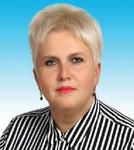
Tetiana Hovorushchenko received the bachelor degree in 2001 and master degree in 2002 in Khmelnytskyi National University (Ukraine). She received the Doctor of Engineering Sciences degree in 2018 in Ukrainian Academy of Printing (Ukraine). She is the head of department of computer engineering and information systems at Khmelnytskyi National University (Ukraine). Research interests: medical decision support systems, software quality evaluation and assurance. She has been serving as a reviewer for many highly-respected journals.

Yelyzaveta Hnatchuk received the bachelor degree in 2002 and master degree in 2003 in Khmelnytskyi National University (Ukraine). She received the Doctor Philosophy degree in Engineering Sciences in 2008 in Lviv Polytechnic National University (Ukraine). She is the associate professor of department of computer engineering and information systems at Khmelnytskyi National University (Ukraine). Research interests: medical decision support systems.

Vitaliy Osyadlyi received the bachelor degree in 2020 and master degree in 2022 in Khmelnytskyi National University (Ukraine). He is the PhD student of department of computer engineering and information systems at Khmelnytskyi National University (Ukraine). Research interests: medical data management and processing based on blockchain technologies.

Mariia Kapustian received the bachelor degree in 2004 and master degree in 2005 in National Aviation University (Ukraine). She received the Doctor Philosophy degree in Engineering Sciences in 2009 in State University of Information-Communication Technologies (Ukraine). She is the of department of computer engineering and information systems at Khmelnytskyi National University (Ukraine). Research interests: systems of information protection, secure corporate networks.

Artem Boyarchuk received the bachelor degree in 2004 and master degree in 2005 in National Aerospace University “Kharkiv Polytechnic Institute” (Ukraine). He received the Doctor Philosophy degree in Engineering Sciences in 2012 in National Aerospace University “Kharkiv Polytechnic Institute” (Ukraine). He is the postdoctoral researcher at department of law, TalTech/Tallinn University of Technology (Estonia). Research interests: information technologies for web-services reliability, artificial intelligence for law.
Journal of Cyber Security and Mobility, Vol. 12_3, 253–274.
doi: 10.13052/jcsm2245-1439.1231
© 2023 River Publishers
